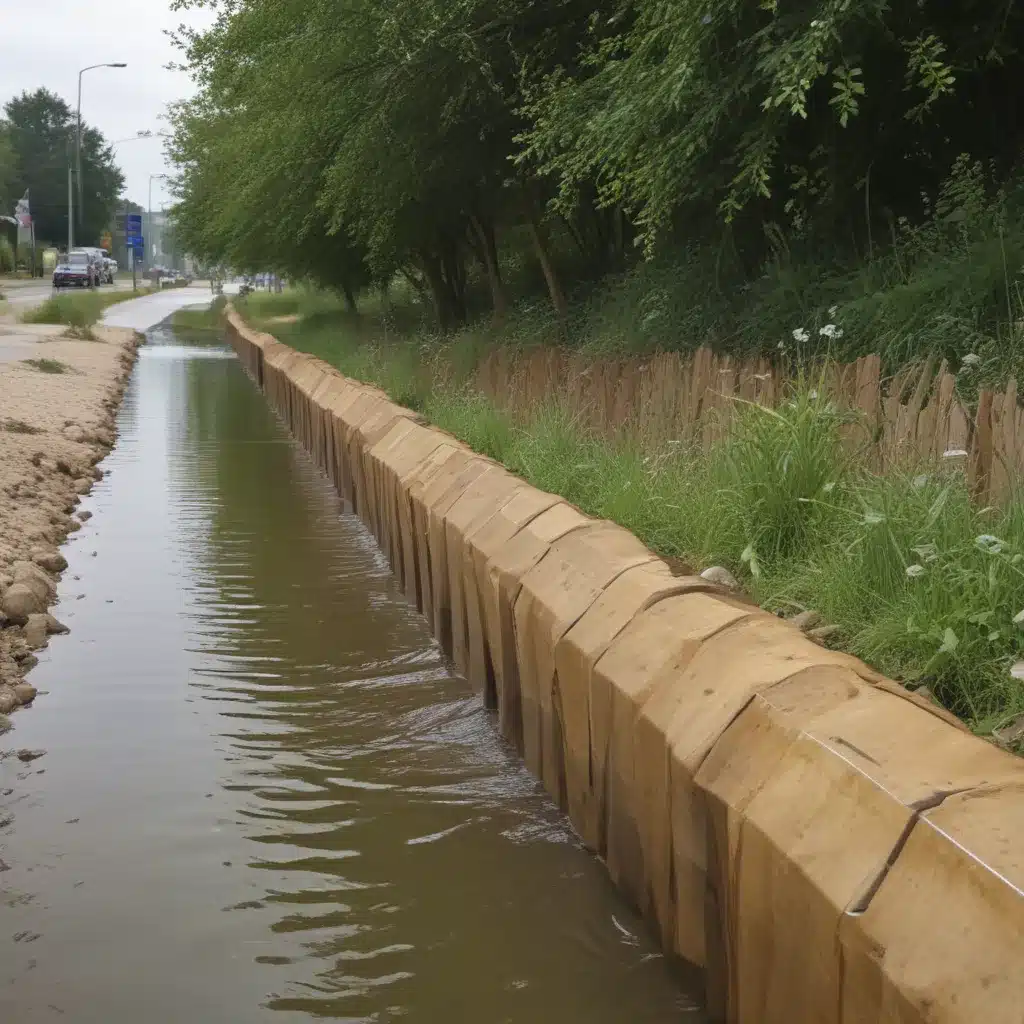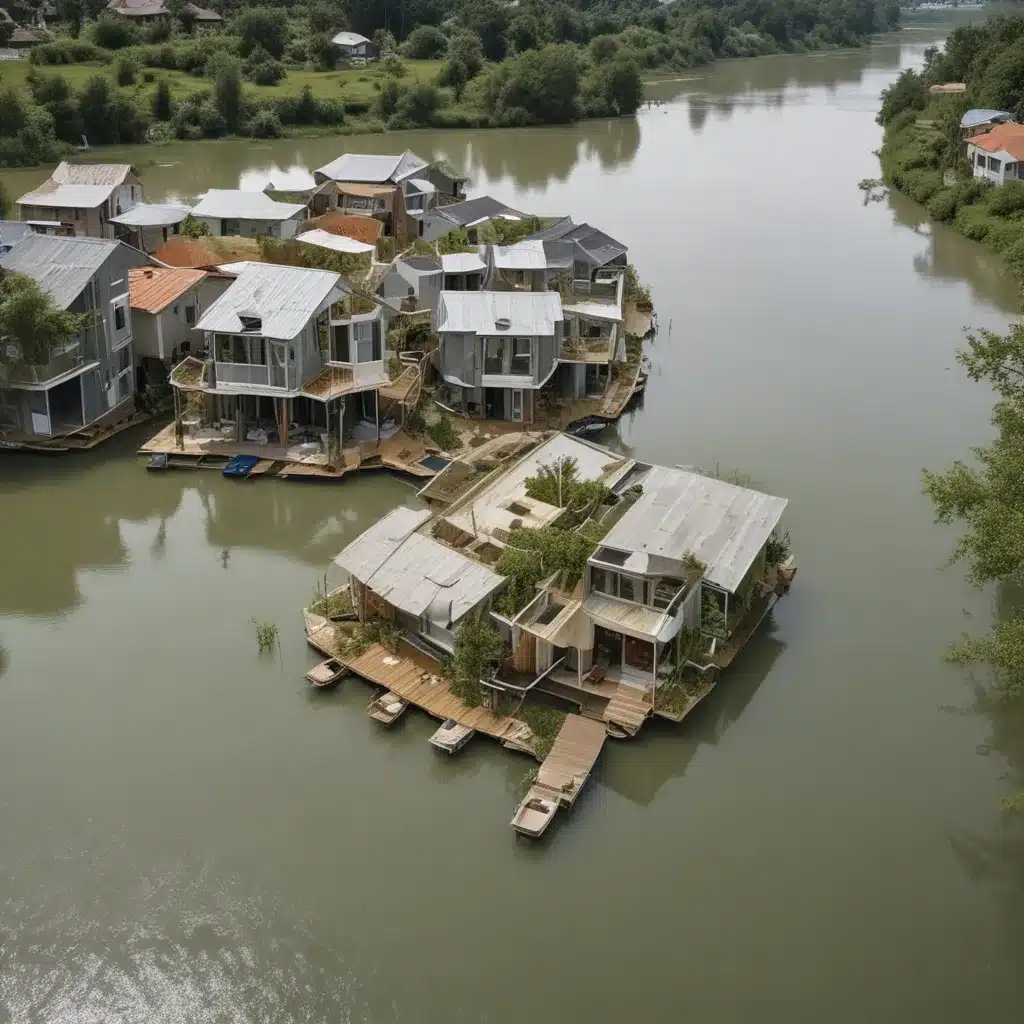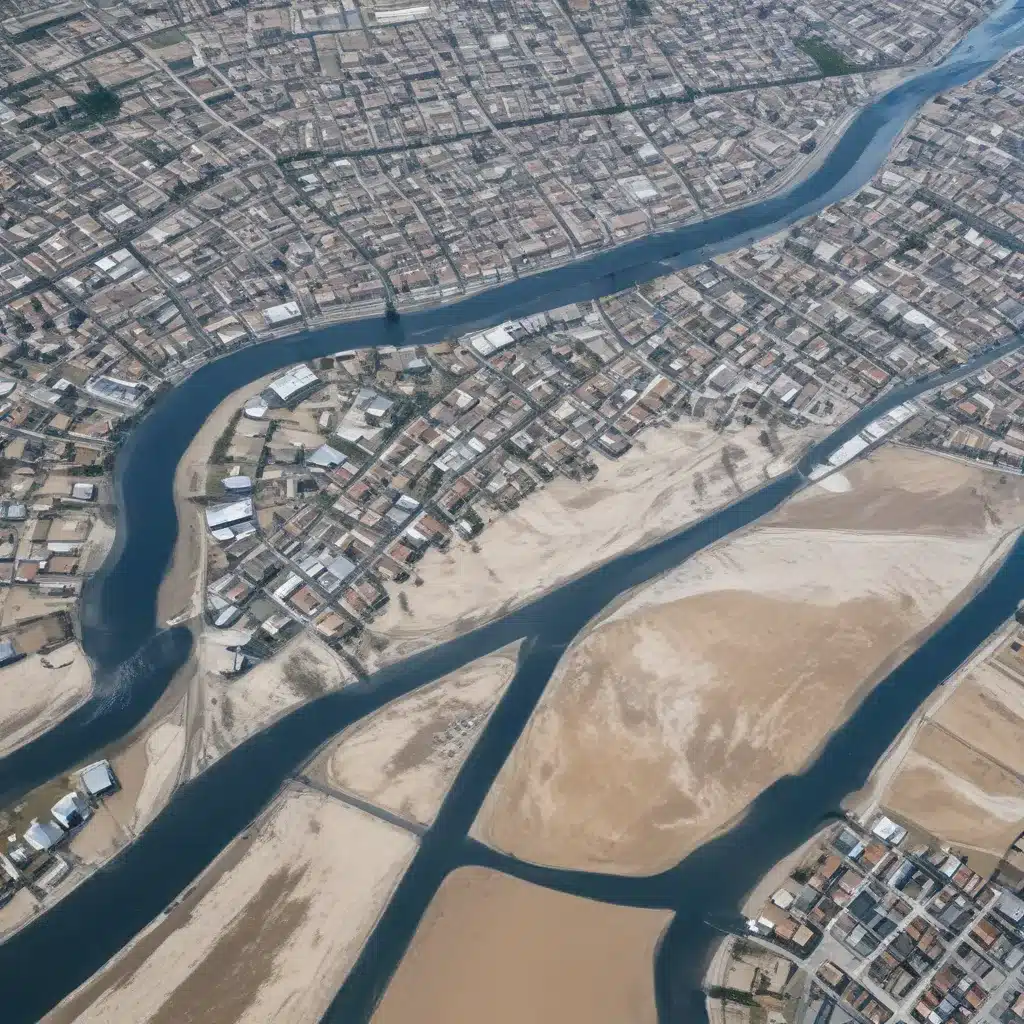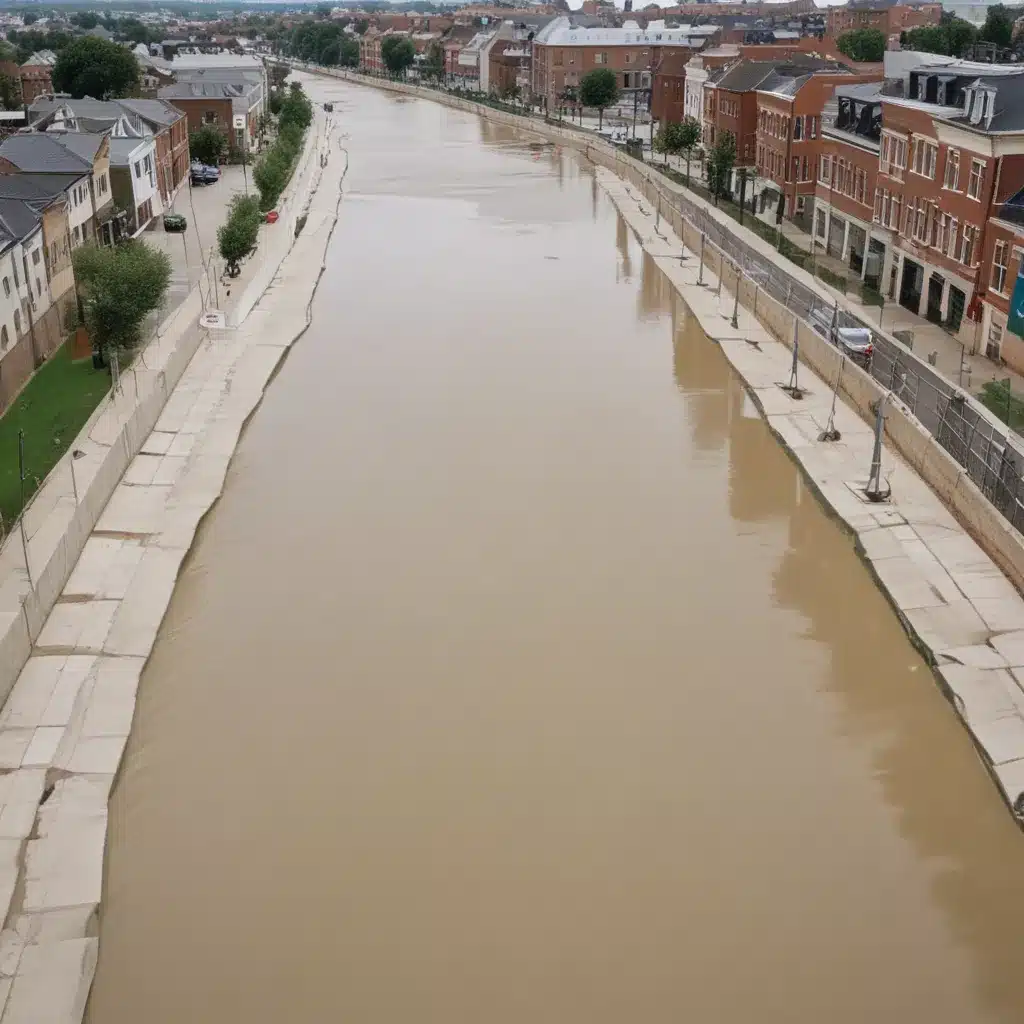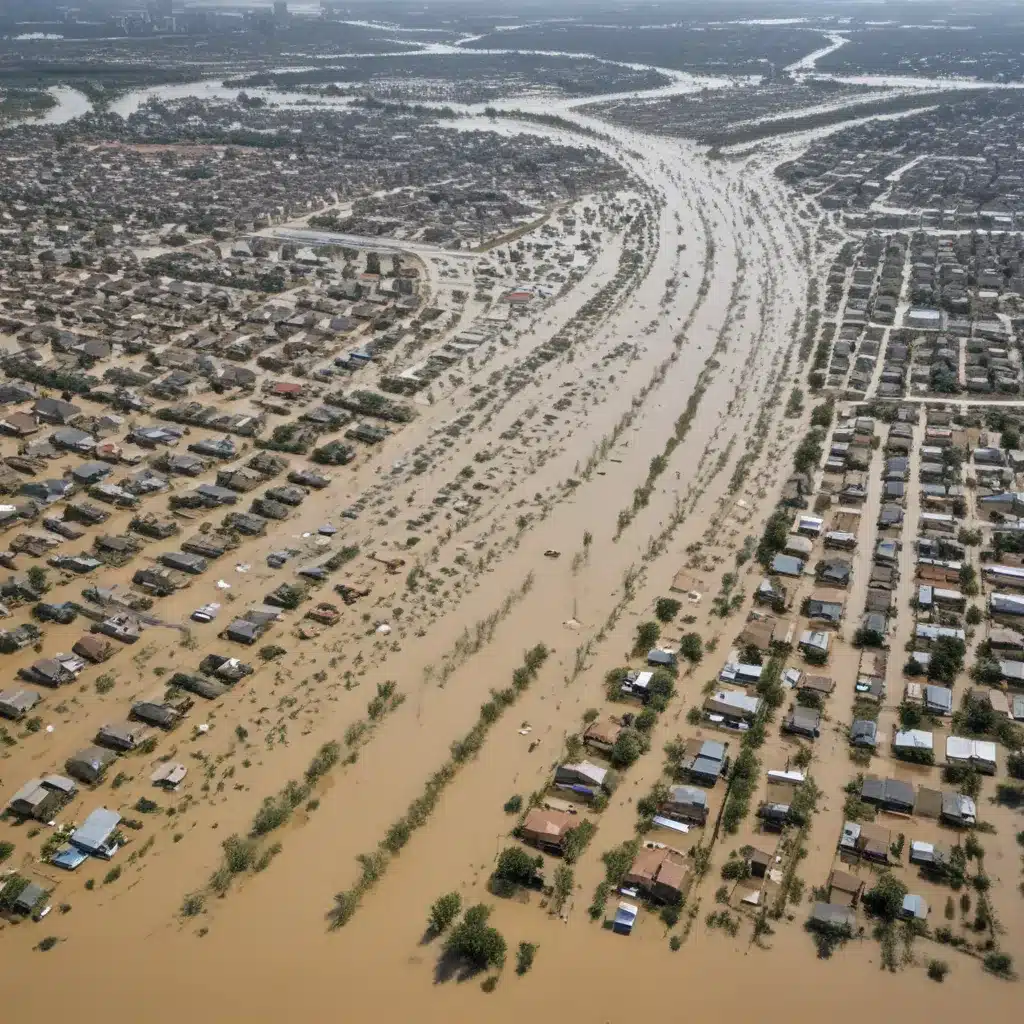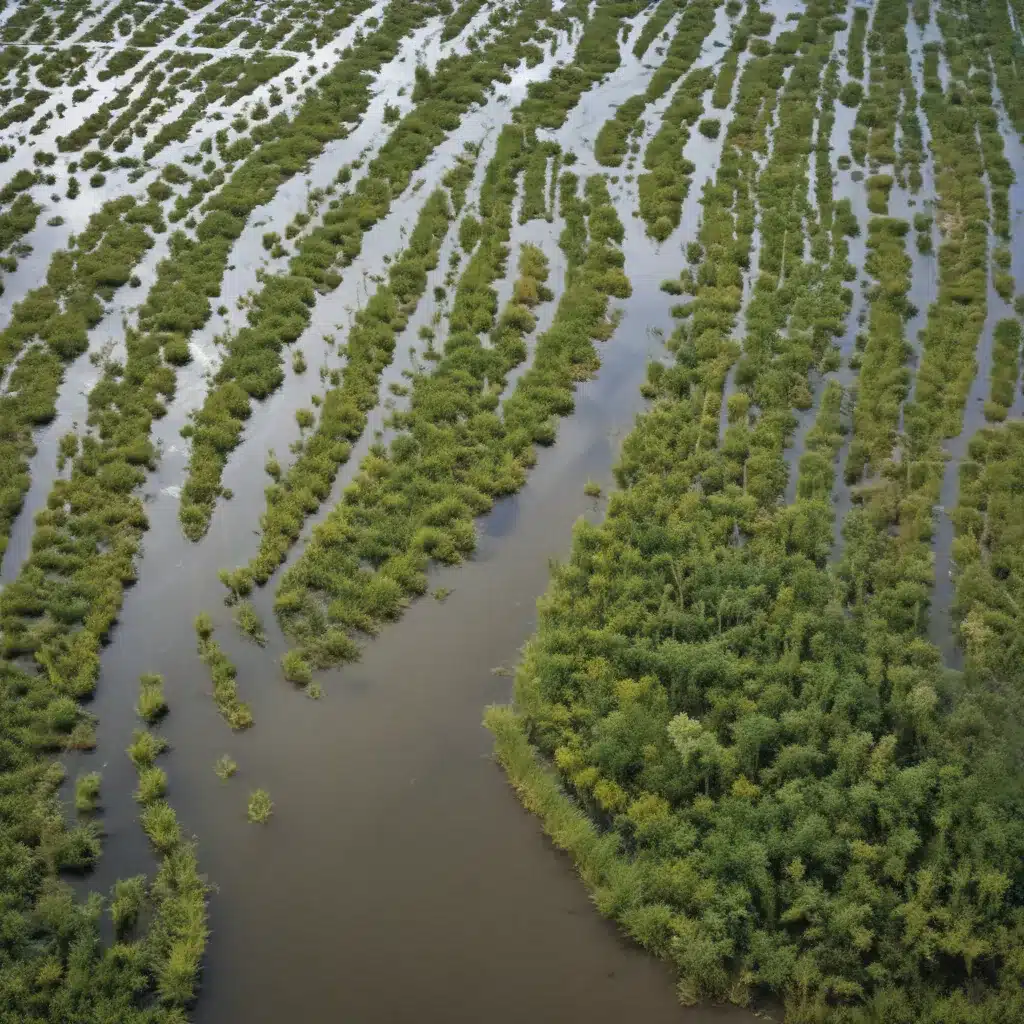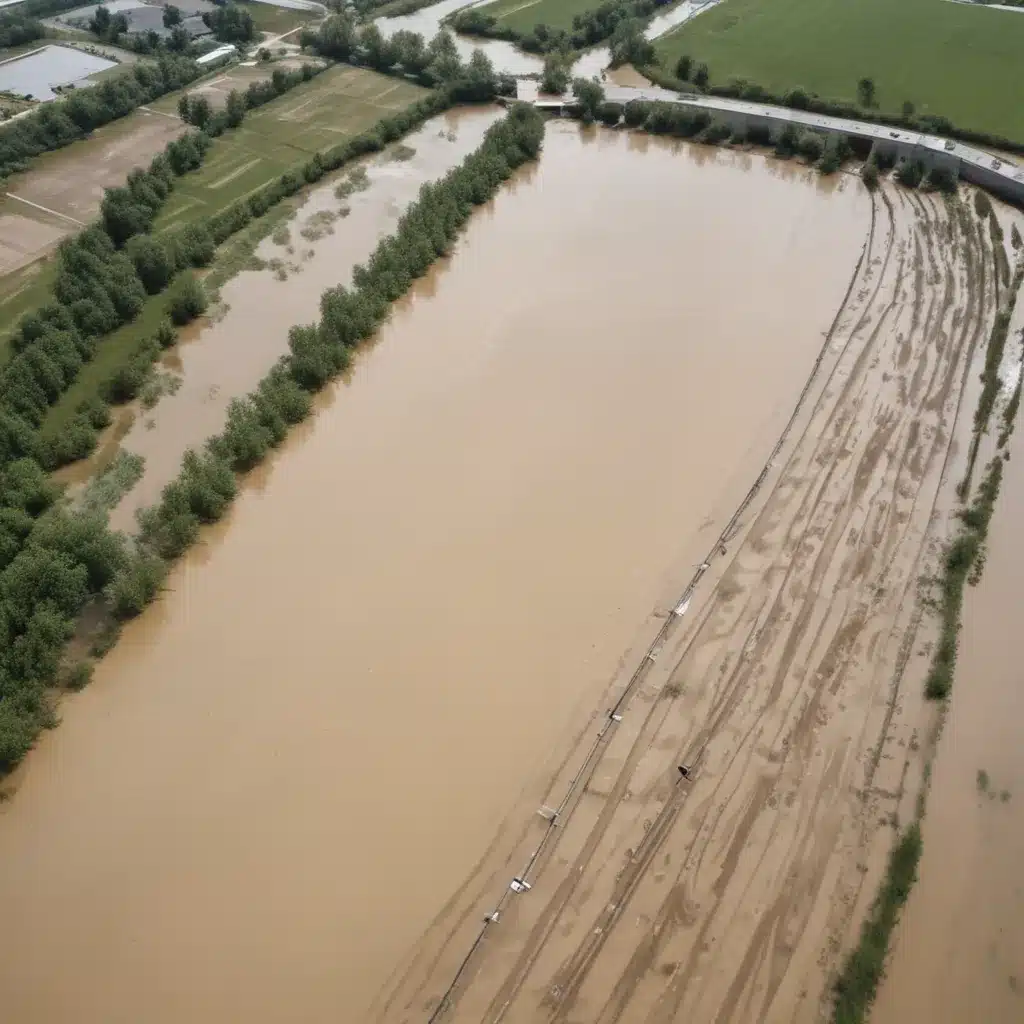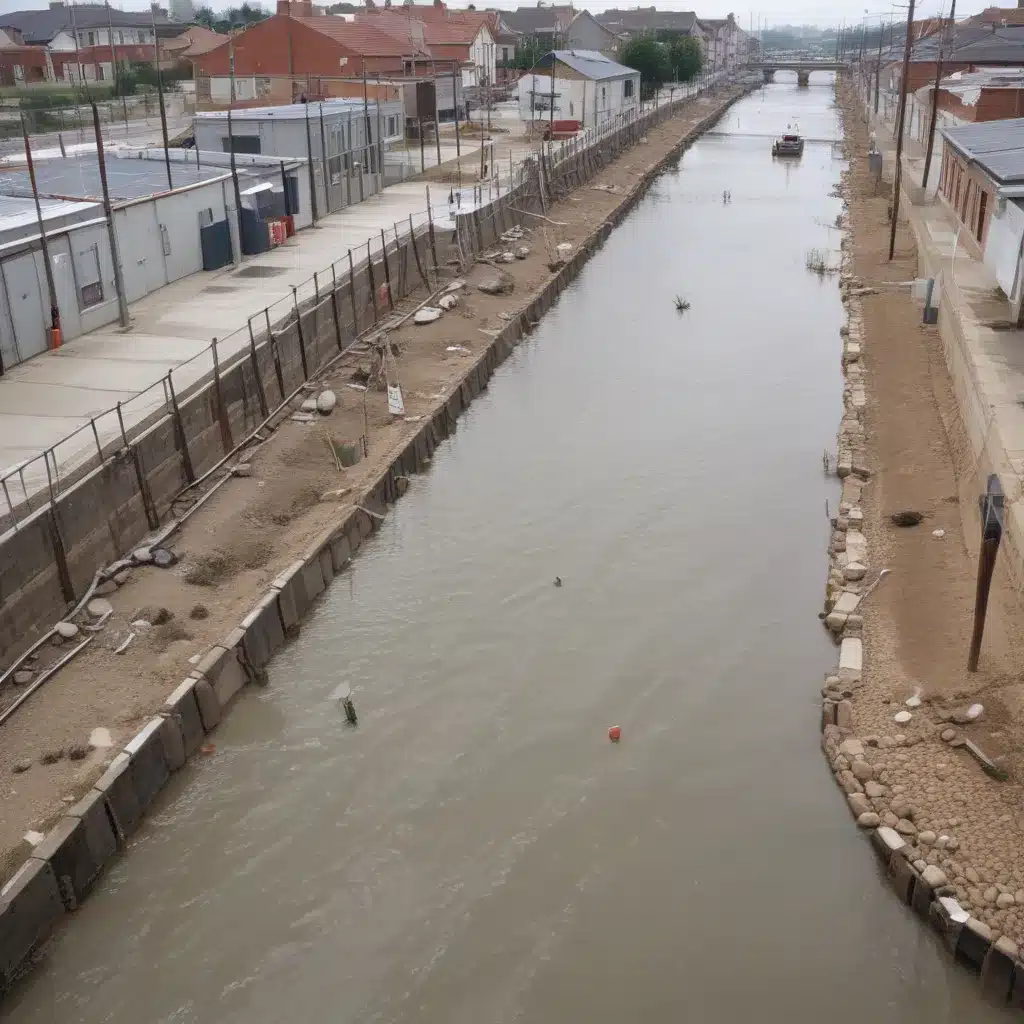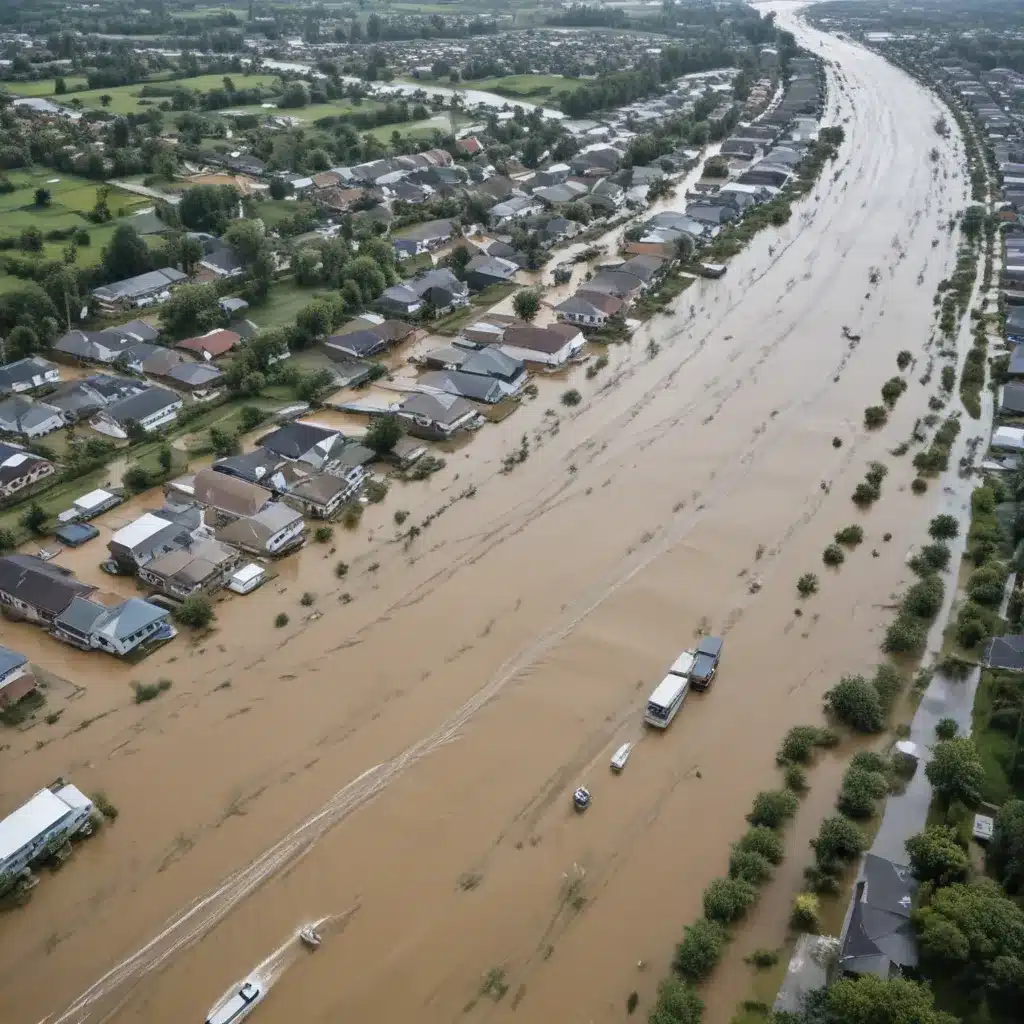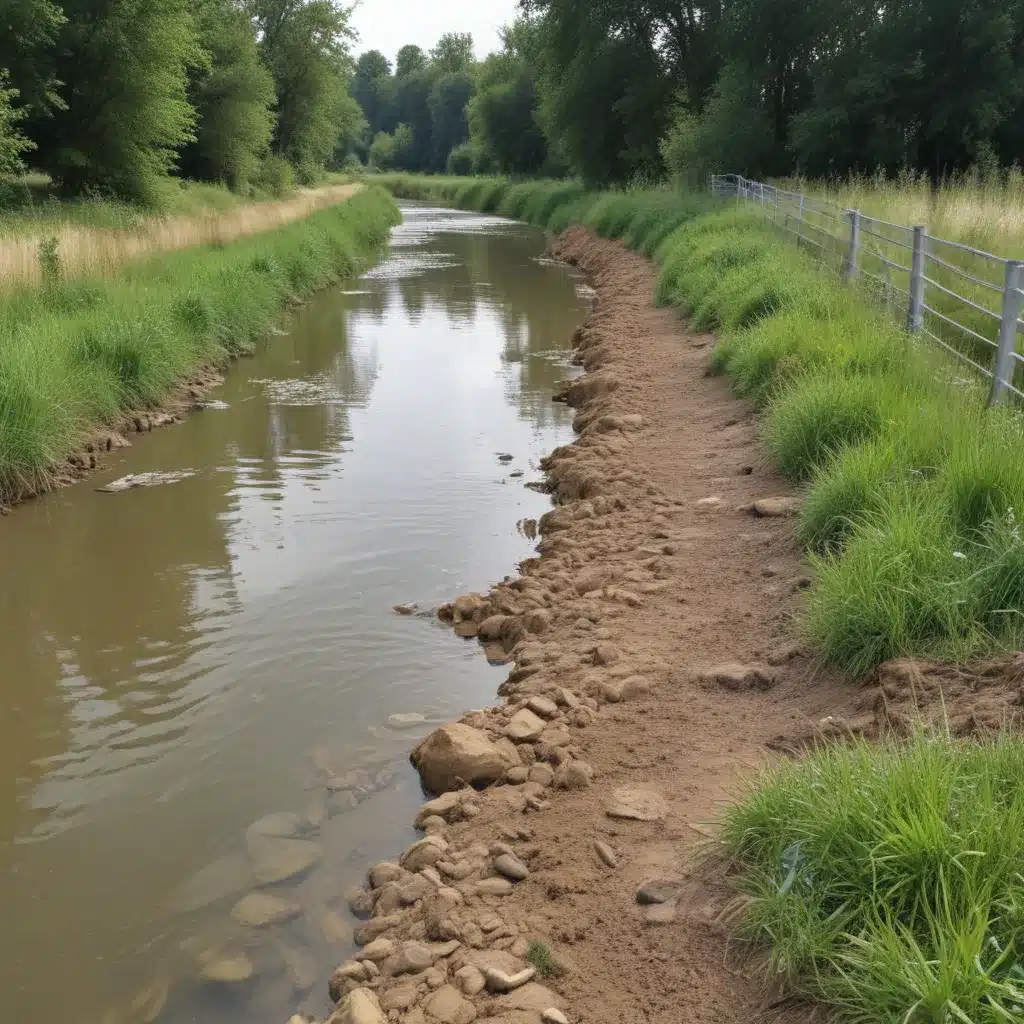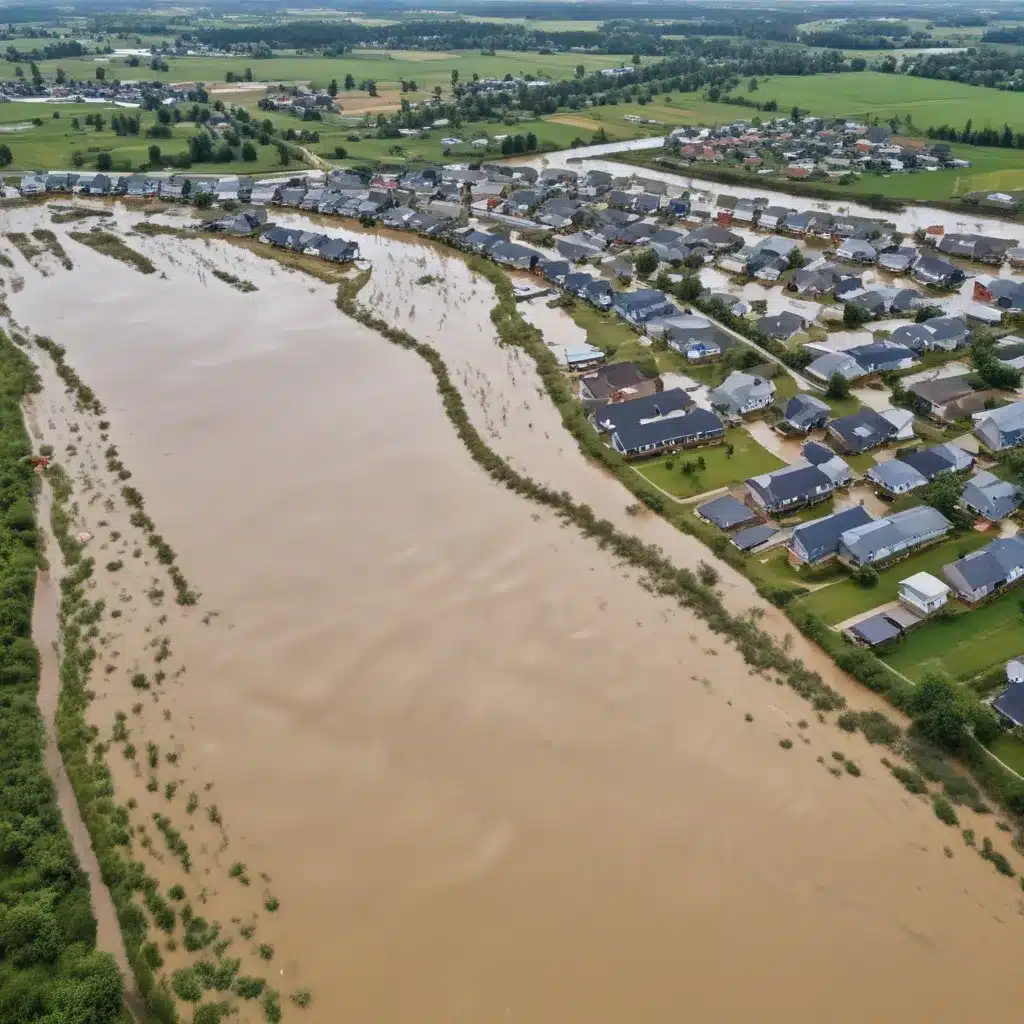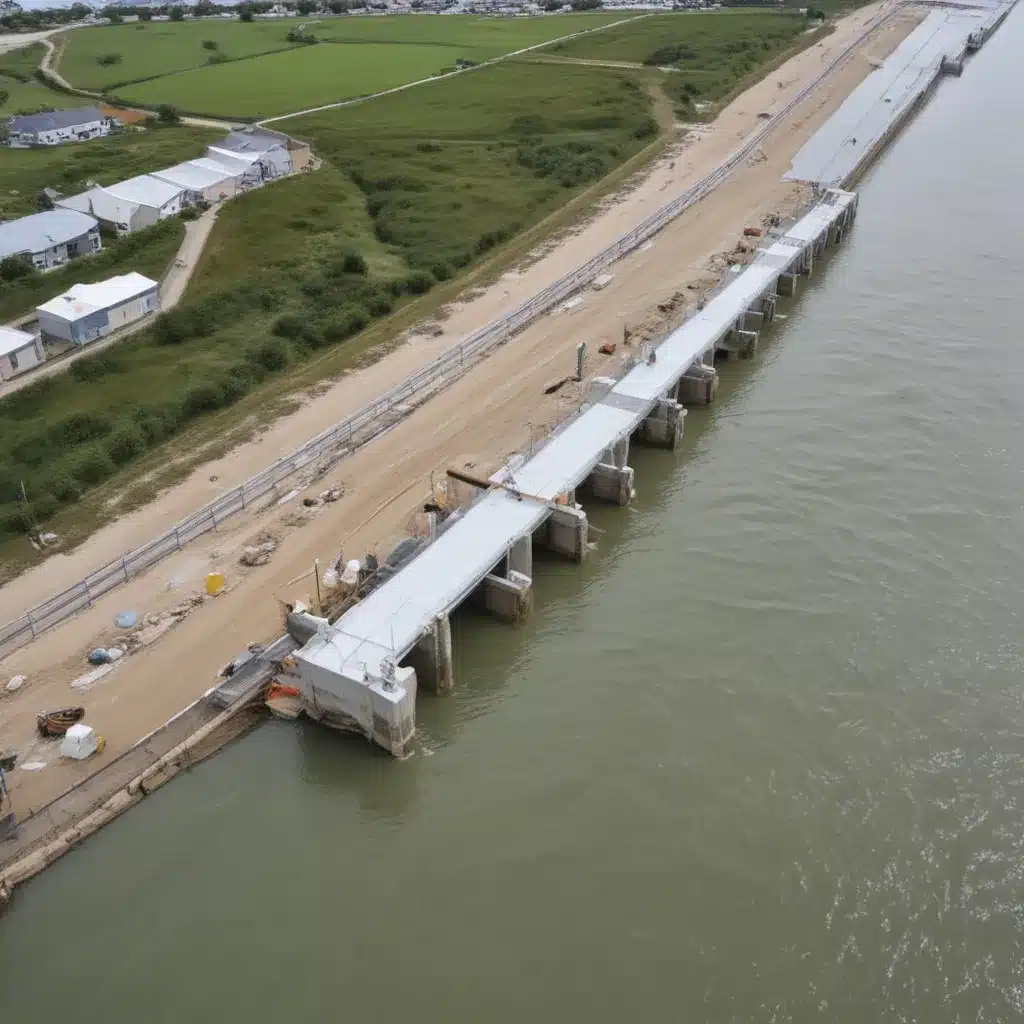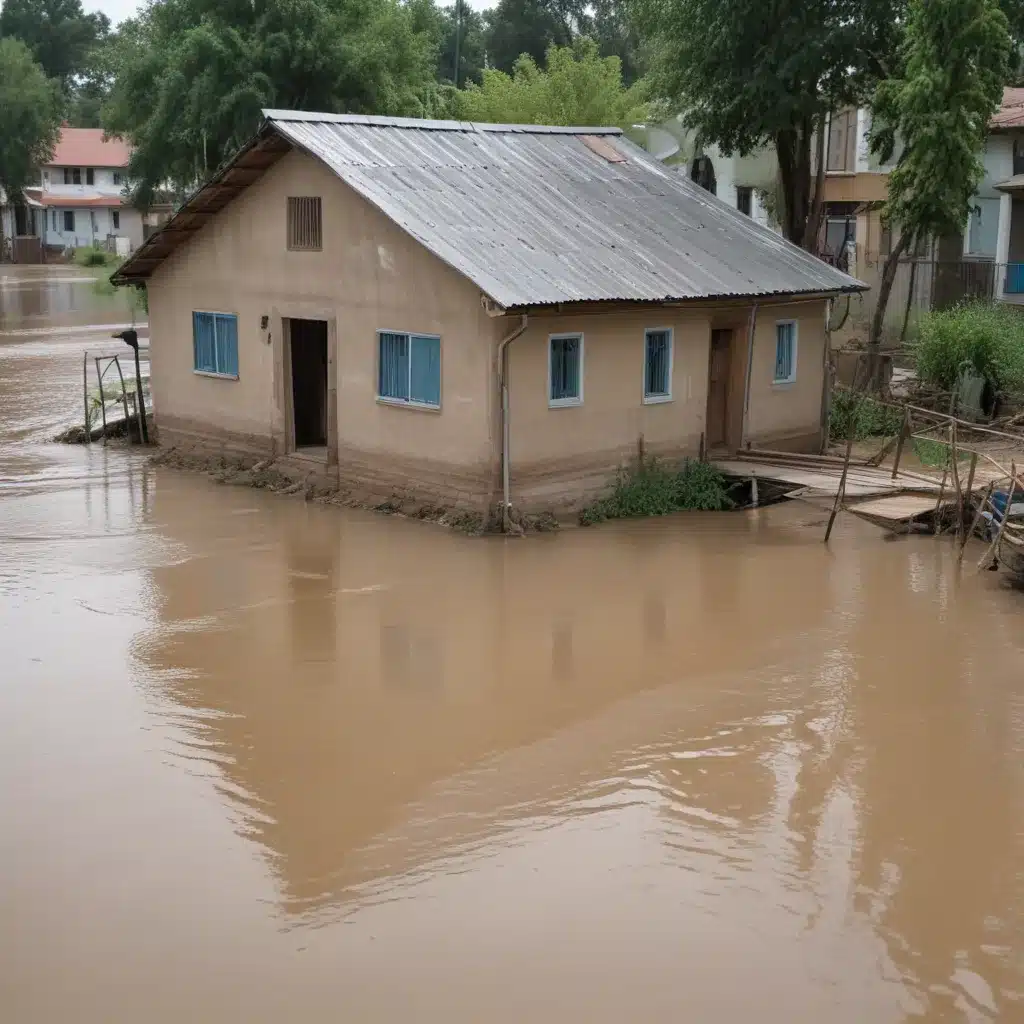As we gaze out upon our community, a tranquil river meandering through its heart, it’s easy to overlook the potential danger that lies beneath its surface. Floods, like silent predators, can strike without warning, leaving devastation in their wake. It is imperative, therefore, that we equip ourselves with the knowledge and tools necessary to understand and assess our community’s flood risk. In this guide, we will explore the importance of assessing flood risk, understanding flood hazard maps, analyzing historical flood data, and identifying high-risk areas. Together, let us embark on this journey of knowledge and resilience, for the safety and well-being of our beloved community depends on it.
Key Takeaways
- Assessing flood risk is crucial for understanding the potential impact on our community and developing effective risk mitigation strategies.
- Flood hazard maps help identify flood-prone areas and provide valuable information for assessing flood risk.
- Factors such as topography, hydrology, historical flood data, and socio-economic factors contribute to flood vulnerability in high-risk areas.
- Analyzing historical flood data and considering the impact of climate change are important for assessing current and future flood risks and developing appropriate mitigation strategies.
Importance of Assessing Flood Risk
Assessing flood risk is crucial for understanding the potential impact on our community. As a community that desires innovation, it is important for us to stay ahead of the curve and use advanced techniques to assess flood vulnerability and mitigate risks effectively.
One of the primary reasons for assessing flood vulnerability is to identify areas within our community that are prone to flooding. By understanding these vulnerable areas, we can develop targeted strategies to minimize the impact of floods and protect our community from potential damage. Assessing flood vulnerability also helps us prioritize our resources and allocate them efficiently to areas that need immediate attention.
To assess flood vulnerability, we utilize various flood risk assessment techniques. These techniques involve gathering data on factors such as rainfall patterns, soil type, topography, and existing infrastructure. By analyzing this data, we can determine the likelihood and severity of flooding in different areas of our community. This information allows us to develop comprehensive flood risk maps and models that help us make informed decisions about land use planning, infrastructure development, and emergency preparedness.
Incorporating innovative technologies like remote sensing, geographic information systems (GIS), and advanced hydrological models, we can enhance our flood risk assessment capabilities. These technologies enable us to gather real-time data, simulate flood scenarios, and predict the potential impact of floods accurately. By harnessing the power of innovation, we can proactively address flood risks, enhance community resilience, and ensure the safety and well-being of our residents.
Understanding Flood Hazard Maps
Let’s talk about understanding flood hazard maps and how they can help us assess the risk in our community. By using map interpretation techniques, we can identify high-risk areas prone to flooding and take necessary precautions. These maps provide valuable information that allows us to make informed decisions and take proactive measures to mitigate the impact of floods.
Map Interpretation Techniques
To better understand flood hazard maps, we can employ various map interpretation techniques. These techniques allow us to extract valuable information from the maps and enhance our understanding of flood risk in our community. One important technique is analyzing flood mapping accuracy. By examining the accuracy of the map, we can determine the reliability of the information it provides. Additionally, we can use visual interpretation techniques to identify key features such as flood zones, river channels, and topographic characteristics. This helps us visualize the potential extent and severity of flooding in our area. Another technique is comparing historical flood events with the mapped flood zones to gain insights into past flood patterns and make informed decisions for the future. By utilizing these map interpretation techniques, we can better understand and mitigate the flood risk in our community.
| Map Interpretation Techniques | Benefits |
|---|---|
| Analyzing flood mapping accuracy | Determine the reliability of information |
| Visual interpretation techniques | Identify key features and visualize flood risk |
| Comparing historical flood events | Gain insights into past flood patterns |
| Geographic Information Systems (GIS) analysis | Analyze spatial relationships for better risk assessment |
| Utilizing advanced modeling techniques | Predict future flood scenarios for effective planning |
Identifying High-Risk Areas
Now, let’s focus on identifying high-risk areas within our community by understanding flood hazard maps. Risk assessment and floodplain mapping are crucial tools in determining these areas. By analyzing these maps, we can pinpoint locations that are susceptible to flooding and develop innovative strategies to mitigate the risks.
Flood hazard maps provide valuable information about the likelihood and severity of floods in specific regions. They consider factors such as topography, hydrology, and historical flood data to identify areas at higher risk. Through this comprehensive analysis, we can better understand the flood hazards our community faces.
Factors Influencing Flood Vulnerability
Understanding the factors that contribute to flood vulnerability is crucial for effectively mitigating and managing the risks associated with flooding in our community. By identifying and addressing these flood vulnerability factors, we can enhance our community preparedness and develop innovative strategies to minimize the impact of future floods.
Several key factors influence the vulnerability of our community to flooding. One important factor is the proximity to bodies of water, such as rivers, lakes, or coastlines. Areas located near these water sources are more susceptible to flooding due to the increased likelihood of heavy rainfall or rising water levels. Additionally, the topography of our community plays a significant role in flood vulnerability. Low-lying areas or regions with poor drainage systems are more prone to flooding, as water tends to accumulate in these areas during heavy rainfall.
Another factor influencing flood vulnerability is the condition of our infrastructure. Aging or inadequate drainage systems can exacerbate flooding by impeding the flow of water and causing water to accumulate in certain areas. In contrast, well-maintained and modern infrastructure can help mitigate the impact of floods by efficiently managing water flow.
The socio-economic factors of our community also contribute to flood vulnerability. Communities with lower income levels may have limited resources to invest in flood mitigation measures, making them more vulnerable to the devastating effects of flooding. Similarly, areas with a high population density may face challenges in evacuating residents during flood events, increasing their vulnerability.
To address these flood vulnerability factors and enhance our community preparedness, we need to foster innovation and collaboration. This can involve implementing sustainable drainage systems, improving infrastructure resilience, and promoting community awareness and education about flood risks. By working together and embracing innovative solutions, we can build a more flood-resilient community that is better equipped to handle future flood events.
Analyzing Historical Flood Data
Let’s now look at the importance of analyzing historical flood data when assessing flood risk in our community. By conducting flood frequency analysis, we can understand the likelihood of future floods and their potential impacts. Additionally, we need to consider the influence of climate change on flood patterns to accurately assess the current and future flood risks we face.
Flood Frequency Analysis
To better understand flood risk in our community, we can analyze historical flood data through a method known as flood frequency analysis. This innovative approach allows us to assess the likelihood and severity of future floods based on past events. By analyzing the frequency and magnitude of floods over a specific period, we can estimate the probability of different flood events occurring in the future. This information is crucial for effective flood risk assessment and planning. Flood frequency analysis helps us identify areas at higher risk, prioritize mitigation efforts, and develop strategies to minimize the impact of potential floods. With this data-driven approach, we can make informed decisions and implement innovative solutions to protect our community from the devastating effects of flooding.
Impact of Climate Change
Analyzing historical flood data allows us to gain insights into the impact of climate change on flood risk in our community. As we examine the data, it becomes clear that the frequency and intensity of flooding events have increased over time. This trend aligns with scientific evidence pointing towards climate change as a contributing factor. To address this issue, we must focus on both climate change adaptation and mitigation strategies. Adaptation involves implementing measures to reduce our vulnerability to future floods, such as improving infrastructure and land-use planning. Mitigation, on the other hand, aims to reduce greenhouse gas emissions and limit the extent of climate change. By combining these approaches, we can proactively manage flood risk and create a more resilient community.
Historical Flood Patterns
By examining historical flood data, we can gain valuable insights into the patterns and trends of flooding in our community. Analyzing flood patterns allows us to evaluate flood risks more effectively and develop innovative strategies to mitigate their impact. By studying the frequency, duration, and intensity of past floods, we can identify areas that are more susceptible to flooding and determine the potential consequences. This information is crucial for urban planning, infrastructure development, and emergency preparedness. Understanding the historical flood patterns enables us to make informed decisions and implement proactive measures to reduce the vulnerability of our community. By harnessing the power of data analysis, we can create a safer and more resilient environment for everyone.
Identifying High-Risk Areas
In order to understand flood risk in our community, it is important to identify areas that are at high risk. This process involves conducting a thorough flood risk assessment and creating accurate flood risk maps. By doing so, we can effectively plan and implement measures to mitigate the impact of flooding in our community. Here are three innovative approaches to identifying high-risk areas:
- Advanced Data Analysis: Utilizing advanced data analysis techniques, such as machine learning algorithms and predictive modeling, we can analyze historical flood data along with various environmental and topographical factors to identify high-risk areas. This approach allows us to uncover hidden patterns and correlations that may not be apparent through traditional methods.
- Remote Sensing Technology: The use of remote sensing technology, such as satellite imagery and aerial drones, can provide valuable information for flood risk mapping. These technologies enable us to obtain high-resolution images and collect data on land cover, elevation, and water flow patterns, allowing for more accurate identification of areas prone to flooding.
- Citizen Science and Crowdsourcing: Engaging the community in flood risk identification can be a powerful tool. By leveraging citizen science initiatives and crowdsourcing platforms, we can tap into the collective knowledge and experiences of residents. This approach not only helps in identifying high-risk areas but also promotes community engagement and ownership in flood risk management.
Assessing Drainage Systems
To continue our exploration of flood risk in our community, we will now focus on assessing the effectiveness of our drainage systems. Proper drainage is crucial in managing and mitigating flood risks, and it requires regular maintenance to ensure its optimal performance. By evaluating our drainage systems, we can identify areas that need improvement and implement innovative solutions to enhance their efficiency.
Effective drainage system maintenance is vital in preventing flooding and minimizing its impact on our community. Regular inspections and cleaning of drains, gutters, and pipes are essential to keep them free from debris and blockages. Additionally, it is important to assess the capacity of our drainage infrastructure and identify any areas that may be prone to failure during heavy rainfall events. By proactively addressing these issues, we can minimize flood risks and protect our community from potential damage.
Urban planning plays a significant role in assessing the effectiveness of our drainage systems. As our community grows and develops, it is crucial to consider the impact that new construction and land use changes may have on our drainage infrastructure. Integrating sustainable drainage solutions, such as green roofs, permeable pavements, and rain gardens, into our urban planning can help reduce the strain on our drainage systems and mitigate flood risks.
Innovative technologies can also aid in assessing and improving our drainage systems. Remote monitoring systems can provide real-time data on water levels and flow rates, enabling us to identify areas of concern and respond promptly to potential flooding. Furthermore, computer modeling and simulations can help us predict the impact of different scenarios on our drainage systems, allowing us to make informed decisions and implement effective flood prevention measures.
Evaluating Infrastructure Resilience
Assessing the resilience of our infrastructure is crucial in understanding its ability to withstand and recover from potential flood events. Evaluating infrastructure resilience involves a comprehensive examination of various factors that contribute to its ability to withstand and adapt to flood conditions. Here are three key aspects to consider when assessing flood vulnerability and evaluating infrastructure resilience:
- Innovative Design Solutions: To ensure the resilience of our infrastructure, it is essential to embrace innovative design solutions that can withstand and even benefit from flood events. This could involve the implementation of flood-resistant materials, elevated structures, or green infrastructure that can absorb and redirect floodwaters.
- Advanced Technology and Monitoring Systems: In our quest for innovation, incorporating advanced technology and monitoring systems can significantly enhance our ability to assess and respond to flood events. This could include the use of sensors, remote monitoring, and real-time data analytics to detect and manage flood risks effectively.
- Collaborative Planning and Preparedness: Evaluating infrastructure resilience also requires collaborative planning and preparedness among various stakeholders. By engaging community members, local authorities, and infrastructure providers, we can develop comprehensive flood risk management strategies that prioritize resilience. This may involve creating emergency response plans, establishing early warning systems, and promoting community education and awareness.
Impact of Climate Change on Flood Risk
As we address the impact of climate change on flood risk, it is important to consider the effects it has on rising water levels. With global temperatures on the rise, glaciers are melting and sea levels are increasing. This leads to higher water levels in rivers and coastal areas, amplifying the risk of flooding in communities.
Climate Change Effects
The increasing frequency and severity of floods due to climate change pose significant risks to our communities. As we strive to find innovative solutions for climate change adaptation and flood risk management, it is crucial to understand the specific effects that climate change has on flood risk. Here are three key effects to consider:
- Rising sea levels: Global warming, melting glaciers and ice sheets contribute to rising sea levels. This increases the risk of coastal flooding and the potential for storm surges to penetrate further inland.
- Intensified rainfall: Climate change leads to more intense rainfall events, resulting in increased surface runoff and higher river discharge. This can overwhelm drainage systems and cause flash floods in urban areas.
- Altered precipitation patterns: Climate change can disrupt traditional precipitation patterns, leading to prolonged dry periods followed by intense rainfall. This uneven distribution of rainfall can exacerbate flood risks in certain regions.
Understanding these effects is essential for developing effective strategies to mitigate and manage flood risks in our communities.
Rising Water Levels
Rising water levels, exacerbated by climate change, significantly increase the risk of flooding in our communities. As our world experiences the effects of climate change, we must find innovative ways to address the challenges posed by rising water levels. Flood forecasting plays a crucial role in mitigating the impact of flooding on our communities. By using advanced technologies and data analysis, we can better predict and prepare for potential flood events. Real-time monitoring systems, satellite imagery, and computer models help us understand the behavior of rising water levels and improve the accuracy of flood forecasts. This enables us to take proactive measures, such as implementing early warning systems and developing evacuation plans, to protect our communities from the devastating consequences of floods. By embracing innovation and utilizing flood forecasting techniques, we can effectively manage the risks associated with rising water levels and safeguard our communities.
Community Engagement and Preparedness
To effectively prepare for flooding, our community must actively engage in awareness and readiness initiatives. Community involvement is crucial in ensuring that everyone understands the risks associated with flooding and the importance of being prepared. By coming together as a community, we can work towards minimizing the impacts of flooding and enhancing our resilience. Here are three innovative ways in which our community can engage and prepare for potential flooding:
- Online platforms for risk assessment: Utilizing technology, we can create online platforms that allow community members to assess their flood risk. These platforms can provide personalized risk assessments based on factors such as location, elevation, and historical flood data. By understanding our specific risks, we can take targeted actions to mitigate them.
- Community workshops and training sessions: Organizing workshops and training sessions can empower community members with the knowledge and skills needed to respond effectively during flooding events. These sessions can cover topics such as emergency planning, evacuation procedures, and first aid. By equipping ourselves with the necessary tools and information, we can better protect ourselves and our neighbors.
- Collaborative planning and communication: Establishing a collaborative planning process involving community members, local authorities, and relevant organizations can foster effective communication and coordination. By working together, we can develop comprehensive flood preparedness plans that address the unique needs and challenges of our community. This collaborative approach also ensures that everyone has a voice in decision-making processes, fostering a sense of ownership and collective responsibility.
Importance of Early Warning Systems
Early warning systems play a crucial role in mitigating flood risks within our community. By receiving timely flood notifications, we can take necessary precautions and evacuate if needed. Additionally, these systems enable emergency response teams to be better prepared, ensuring a swift and effective response to minimize property damage and protect lives.
Timely Flood Notifications
When it comes to protecting our community from flood risks, one crucial element that cannot be overlooked is the importance of having a reliable early warning system in place. Timely notifications play a vital role in ensuring flood preparedness. Here are three reasons why timely flood notifications are essential:
- Rapid response: With timely notifications, individuals and authorities can take immediate action to mitigate the impact of floods. This includes evacuating residents, securing vulnerable infrastructure, and providing emergency aid.
- Minimizing loss: Early warnings enable residents and businesses to prepare for floods by moving valuables to higher ground, reinforcing structures, and implementing flood protection measures. This proactive approach helps minimize property damage and economic losses.
- Saving lives: Timely flood notifications can significantly reduce the risk of fatalities. By receiving early warnings, people can evacuate to safer areas or take necessary precautions, ensuring their safety and well-being.
Innovation in early warning systems is crucial to enhance the accuracy and timeliness of flood notifications, empowering our community to stay one step ahead of potential flood risks.
Emergency Response Preparedness
Having a reliable early warning system is crucial for effective emergency response preparedness in our community. By utilizing innovative technology and implementing comprehensive emergency response training, we can enhance our ability to respond swiftly and efficiently to flood events. Through community outreach programs, we can ensure that every resident is informed and prepared for potential emergencies.
To illustrate the importance of early warning systems, let’s consider the following table:
| Early Warning System | Benefits |
|---|---|
| Advanced Weather Monitoring | Timely detection of potential flood events |
| Real-time Data Analysis | Accurate prediction of flood severity |
| Automated Alert Systems | Rapid dissemination of crucial information |
| Integration with Mobile Apps | Convenient access to emergency updates |
Minimizing Property Damage
Implementing early warning systems is crucial in minimizing property damage caused by flood events in our community. To achieve effective property protection and reduce the impact of floods, it is important to embrace innovative solutions. Here are three key reasons why early warning systems are essential:
- Timely alerts: Early warning systems provide real-time information about approaching floods, allowing residents to take immediate action to protect their properties. With advanced technology and data analysis, these systems can accurately predict flood events, giving homeowners valuable time to implement flood-resistant construction measures.
- Enhanced preparedness: By receiving early warnings, residents can proactively prepare their properties for potential flooding. This may include elevating valuables, installing flood barriers, or reinforcing structures. Early warning systems empower individuals to make informed decisions to minimize property damage.
- Community safety: Early warning systems not only protect individual properties but also contribute to the overall safety of our community. By reducing property damage, these systems help prevent displacement, financial losses, and potential injuries or casualties during flood events.
Flood Insurance and Financial Protection
To ensure financial protection against potential flood damage, individuals and communities must have flood insurance. Flood insurance coverage provides the necessary financial assistance to recover from the devastating effects of floods. Without proper coverage, individuals and communities may face significant financial burdens that can hinder their ability to rebuild and recover.
One of the key advantages of flood insurance is its ability to provide financial support for both property damage and personal belongings. In the event of a flood, having flood insurance coverage can alleviate the financial strain of repairing or replacing damaged property. It can also assist in replacing personal belongings that may have been lost or damaged due to flooding.
To further emphasize the importance of flood insurance, let us consider the following table:
| Without Flood Insurance | With Flood Insurance | |
|---|---|---|
| Financial Protection | Limited or no coverage for flood damage | Comprehensive coverage for flood damage |
| Rebuilding and Recovery | Financial burden on individuals and communities | Financial assistance for rebuilding and recovery |
| Peace of Mind | Uncertainty and financial stress | Assurance and peace of mind |
As seen in the table, having flood insurance offers significant advantages in terms of financial protection, rebuilding and recovery, and peace of mind. By investing in flood insurance, individuals and communities can proactively mitigate the financial risks associated with flooding, ensuring a more secure and stable future.
Developing Emergency Response Plans
We must prioritize the development of effective emergency response plans to ensure the safety and well-being of our community during flood events. To achieve this, we need to focus on the following:
- Emergency Response Training: Our community members must receive proper training on how to respond in emergencies. This training should include basic first aid, search and rescue techniques, and how to safely evacuate during a flood. By equipping our residents with the necessary skills and knowledge, we can enhance our community’s resilience and ability to handle flood-related emergencies.
- Community Evacuation Plans: Developing comprehensive evacuation plans is essential in minimizing the risks associated with flooding. These plans should include designated evacuation routes, assembly points, and shelters. All community members must be aware of these plans and know how to access them in times of need. Additionally, technological advancements such as mobile apps or automated alert systems can be utilized to provide real-time updates and instructions during emergencies, ensuring the efficient and safe evacuation of our community.
- Innovative Solutions: To stay ahead of the curve and effectively respond to flood events, we must embrace innovation. This includes leveraging technology to improve our emergency response capabilities. For example, using drones for search and rescue operations can significantly reduce response times and increase the chances of saving lives. Additionally, investing in smart infrastructure that can detect rising water levels and automatically trigger evacuation alerts can greatly enhance our community’s readiness and resilience.
Mitigation Strategies for Flood Risk
Developing effective mitigation strategies is crucial in reducing the risk of flooding in our community. As we strive for innovation in tackling this issue, it is important to explore various mitigation techniques that can help us better manage flood risk. One such technique is floodplain zoning.
Floodplain zoning involves identifying and designating areas that are prone to flooding as “floodplains.” By implementing regulations and restrictions for development in these areas, we can minimize the potential damage caused by flooding. This approach allows us to strike a balance between accommodating growth and ensuring the safety of our community.
Innovative floodplain zoning strategies can include adopting land-use regulations that prohibit or limit construction in high-risk flood zones. Additionally, implementing building codes and standards that require flood-resistant design features, such as elevated foundations or flood barriers, can help mitigate the impact of flooding on structures. By incorporating green infrastructure, such as permeable pavements or rain gardens, we can also manage stormwater runoff more effectively, reducing the likelihood of flooding.
Furthermore, embracing technological advancements can enhance our flood risk mitigation efforts. Utilizing real-time monitoring systems, predictive modeling, and data analysis can provide us with valuable insights into flood patterns and help us make informed decisions when it comes to land-use planning and emergency response.
Engaging With Local Authorities
Engaging with local authorities is essential for effective flood risk management in our community. When we actively involve our community in the decision-making process and work together with local authorities, we can create innovative solutions to address flood risks. Here are three ways we can engage with local authorities to ensure community involvement in flood risk management:
- Collaborative workshops: Organize workshops where community members, local authorities, and experts can come together to brainstorm and develop strategies to mitigate flood risks. This collaborative approach fosters innovation and allows for the exchange of ideas and knowledge between different stakeholders. By involving local authorities in these workshops, we can ensure that their expertise and resources are utilized effectively.
- Community forums: Host community forums where residents can voice their concerns, share experiences, and provide input on flood risk management plans. Local authorities can actively participate in these forums, listen to community members, and incorporate their feedback into decision-making processes. This approach promotes transparency and inclusivity, ensuring that the diverse perspectives and needs of our community are considered.
- Partnership programs: Establish partnership programs between local authorities and community organizations to jointly develop and implement flood risk management initiatives. Through these partnerships, we can leverage the strengths and resources of both parties to implement innovative solutions. This collaborative approach enables us to tap into the creativity and expertise of the community while benefiting from the guidance and support of local authorities.
Building a Resilient Community
To ensure the long-term success of our flood risk management efforts, it is crucial to focus on building a resilient community. Building resilience within our community is not just about mitigating the impacts of flooding but also about equipping ourselves to adapt and recover quickly. By enhancing our community’s preparedness, we can minimize the damage caused by floods and bounce back stronger than ever.
One key aspect of building resilience is community preparedness. This involves educating and empowering our residents with the knowledge and skills necessary to respond effectively in the event of a flood. It is essential to disseminate information about flood risks, evacuation routes, and emergency procedures through various channels such as community meetings, social media, and local newsletters. By doing so, we can ensure that everyone understands the potential risks and knows how to take appropriate action.
Another important aspect of community resilience is establishing partnerships and networks that can provide support during emergencies. We can collaborate with local businesses, nonprofit organizations, and government agencies to develop a coordinated response plan. By working together, we can leverage resources and expertise to enhance our community’s ability to withstand and recover from flood events.
To illustrate the importance of building resilience, consider the following table:
| Building Resilience | Benefits |
|---|---|
| Community education and awareness programs | Empowers residents to take proactive measures and make informed decisions |
| Infrastructure improvements | Enhances the ability to withstand flood events and reduces recovery time |
| Early warning systems | Provides timely alerts and enables evacuation plans to be activated promptly |
| Community-based emergency response teams | Increases the speed and effectiveness of response efforts |
| Collaborative partnerships | Facilitates resource sharing and enhances overall preparedness |

